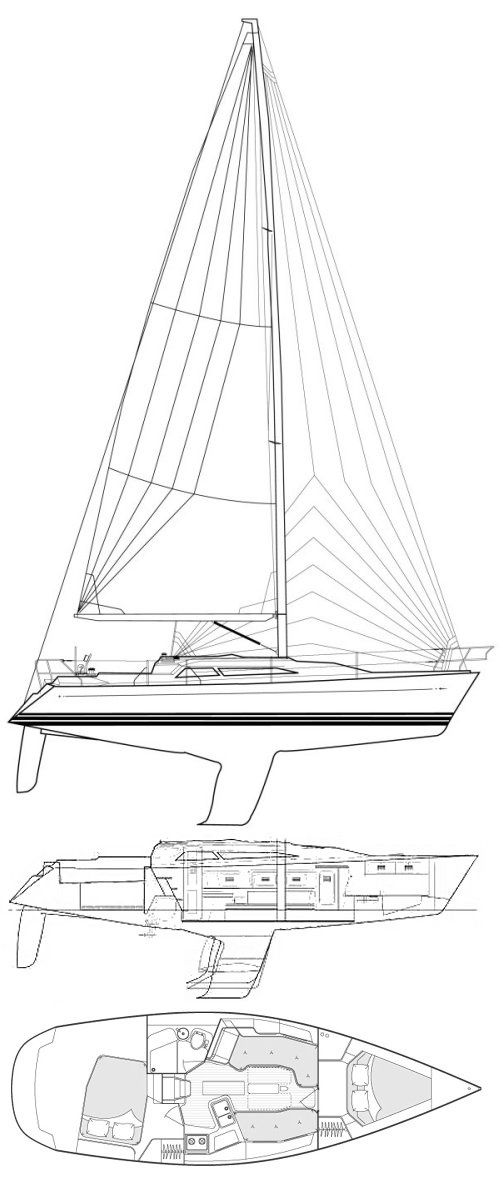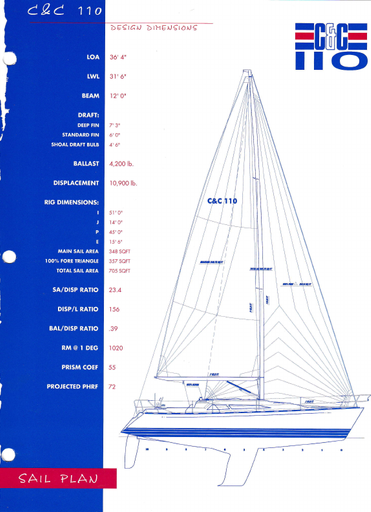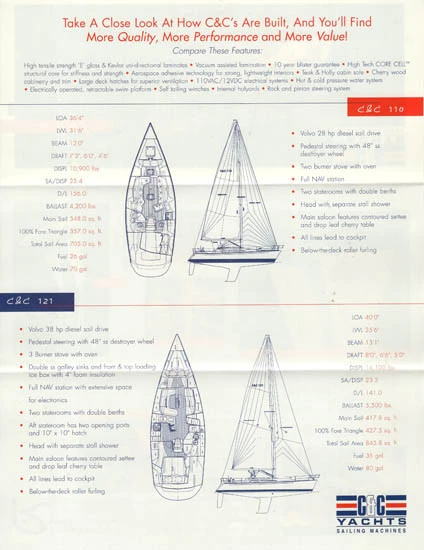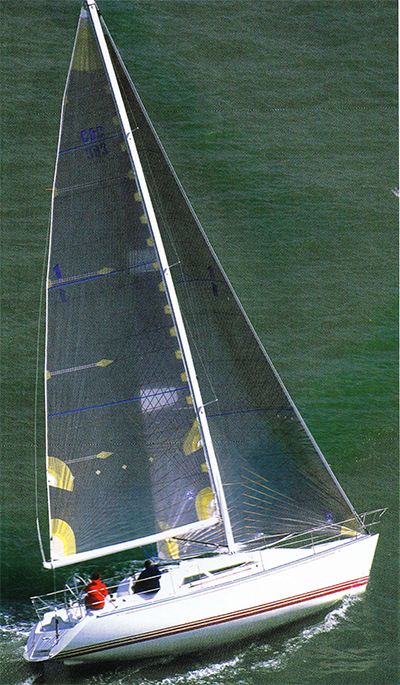



C&C 110
LOA: 36' 4" LWL: 31' 5"
DWG #
T1997-110
Designer / Draughtsman
Year of Design
1997
Builder
Tartan Yachts
Notes
By Heather Ormerod
In sailing circles, C&C is arguably one of Canada's most famous companies. And ever since the demise of this company, there has been talk of its revival. If I had a dollar for every time I heard talk of the mythical C&C rising from the ashes yet again, I could probably have bought the company myself. Or at least one of those C&C 36 Mk I - they just don't make them like that anymore. But it appears the rumour mill can finally take up a new subject, because I've seen the long anticipated C&C 110 and unquestionably, C&C is back.
That being said, this is not the company's return, so much as its name. Fairport Marine purchased the C&C name and assets, and production now takes place at Fairport's facility in Ohio. Unlike past attempts which have attempted to reassemble the old company or revive old product, Fairport aims to produce a new generation of boats "with a strong respect for the C&C design lineage." As a result, the new C&C 110, both is and is not a C&C. On one hand, the boat as a racer/cruiser, with emphasis on the racer side of the equation, reflects C&C's origins in high performance. The lines of the coach roof are reminiscent of the C&C 34R and 34+ series. The toe rail and the port lights are also clearly C&C-like and the distinctive C&C cove stripe is still in place. On the other hand, there is also not one piece of teak to be found above decks, the widened transom gives the boat a very different look from behind the wheel and the interior bears few similarities to the classic C&C interiors.
But despite what the purists are bound to say, this split personality is not necessarily a bad thing. Many of the changes reflect developments in boat building and market demands, and Fairport has, quite rightly, integrated these features into the new generation of C&C boats. As a result, the new boats are fast, but can be sailed more comfortably and safely with less crew.
The widened transom is one of the best new features. The cockpit on the 110 is huge and quite comfortable. This is achieved with deep coamings and a custom deck layout which keeps the working area uncluttered, while still leaving room for passengers. While behind the wheel the skipper can reach the furling line (which is right by his or her feet), reach back and adjust the hydraulic split backstay, or drop down the mechanical transom with the push of a button. Genoa sheets are led back through turning blocks to winches stationed just ahead of the wheel. The boat can be ordered with a single-handers package, which will lead the mainsheet, main halyard and reefing lines back to the helm. There is lots of room up on the bow for spinnaker work. And once the spinnaker is doused, it can be stowed in the roomy anchor locker.
Fairport has chosen to use below-decks Harken furling, which provides for a decksweeper jib - the perfect trade-off to ensure simple sail handling and strong performance. Single-line reefing for the main is lead aft. Windage is reduced by running the 8: 1 purchase mainsheet internally through the boom to the traveler on top of the coach house. A solid Offshore vang keeps the boom in control. The Edson steering pod on the test boat featured the Autohelm Tridata system and a Ritchie compass. The steering system was designed specifically for the C&C 110, and this is very apparent when you are at the helm. Steering with the CD-i Rack and Pinion Steering System, designed by Rob Ball, who was the Chief Designer at C&C Yachts for 20 years is incredibly smooth and its gears are estimated to have three times the life span of conventional rack gears. Someone interested in racing around the cans should invest in the deluxe equipment package. Jibing in 20 knots of air with single sheets and guys without the optional Lewmar 40 AST secondary winches would be somewhat of a circus act. The secondaries would come in handy at leward mark when rounding in close quarters as well.
Buyers can choose between a deep fin, standard fin and a shoal draft bulb, all manufactured by Canada's Mars Metal Company, which has become the company of choice for many high-performance boats. The keel designs feature the NASA developed high lift foils with a bulbed tip to further lower the ballast. The triple spreader rig, manufactured by Offshore Spars, is fairly powerful for a 36-foot boat, but there is a lot of sail area to support. Sails are left up to the buyer. Our boat had a set of Ullmer Kolius tape drive sails.
C&C 110 - Sails downDown below
As you descend the ladder into the cabin, you are immediately met by the cool, clean look of cherry. This light, pretty wood keeps the interior bright, giving the illusion of more space. It is accented by detailing bands which also double as vents for the cupboards. Behind the port side settee are two cupboards, one with a built-in bar. It can be a bit of a squeeze past the centreline drop-leaf table in the centre of the two curving benches that form the salon, but if you keep moving forward you will enter a huge V-berth area, that is filled with natural light thanks to the massive hatch above. This space will come in handy on the race course and on cruising weekends. If you choose to fill your V-berth with people, they will find plenty of storage space in a large hanging locker. The bunk in the cabin is at a very comfortable height, so you can actually just sit down on it.
Back in the main cabin, there is head room for the average sailor and indirect lighting casts a warm glow. The table, which has drawers in the end of it, is completely removable. There is a small navigation station at the end of the port bench. A stainless-steel back rest with a cushion folds out from under the chart table surface to conserve space. While sitting at the chart table, you face into the electrical panel, which folds down for maintenance and there is room on this panel to install a nav-plotter, radar screen repeater or any other electronic device.
The head is located on the port side of the boat at the foot of the ladder. There is good head room in here too, but the most striking feature of this compartment is the separate shower stall that is formed by an attractive Plexiglas wall with stainless steel supports. This not only looks nice, but it will help contain the spray and suds - keeping head maintenance at a minimum.
The galley doesn't offer a lot of counter space, but deep sinks, a cutting board with draining grooves and a fold-out garbage bin are all examples of how the company makes the most of what space there is. Hot and cold pressure water is available, but if you are short of power, a manual fresh water foot pump can be used. There is a microwave and a two-burner, gimballed stove with oven for cooking and a propane fume detector for those who are nervous about propane in the cabin.
The entrance to the aft double quarterberth is located off of the galley. The racing bent of this boat keeps the quarter berth relatively small, but the bunk is low and there is good height at the head of the bunk in this little cabin. Back rest cushions transform the bunk into a comfortable seat for reading, and the two ports allow plenty of natural light to flood in. The engine compartment for the Yanmar saildrive is also tucked back in the aft cabin. Even so, it is surprisingly quiet back there when the engine is running and this location has excellent access to all sides of the engine.
On the water
By the time we set out from the dock, the sky had clouded over and what little wind there was soon died out completely. We did actually make progress in these conditions, which gave me my first clue as to how fast this boat could be, but realistically we couldn't test the boat. Haul-out was just around the comer, so I went in search of someone who had taken the C&C 110 for a spin in a little more wind.
Bruce Brown, who has owned a C&C 36 and a C&C 27 Mk IV, and some of his regular crew took the same C&C 110 out for National Yacht Club's end of the season Around the Island Race and were fortunate to have a warm, sunny day, with 10 to 12 knots from the east, which through the early afternoon, became lighter and clocked to south-west.
Here is what he had to say about the C&C 110 under sail:
"Most of the fleet had gathered off Ontario Place and were then lead through the Western Gap by the committee boat for a start from inside Toronto Harbour. The 110 turned more than a few heads (some literally, as we overtook other boats) demonstrating good tacking angles and excellent upwind boat-speed in tight quarters, through the six or seven tacks required to close through the gap straight upwind.
"The boat has a very light sensitive helm, more like what one might expect of a 30-foot MORC vessel. It demonstrated surprising acceleration out of tacks and in response to sail trim. This permitted us to mix right in on the prestart manoeuvres and to accelerate into clear air after the gun.
"My diminutive female crew (who describe themselves as altitudinally and testosterone challenged) were pleased with the ease of sail handling and trimming. In particular, they liked the intelligent manner in which all the controls lead back under the coach roof and the geometry of a very roomy cockpit that permitted them to easily work the primaries. This is a boat which can be sailed without the usual contingent of deck apes or winch beefcakes.
"Above decks, the layout of the 110 is very much club and interclub race oriented. Below decks it is a very well appointed cruiser providing comfortable accommodation dockside or at anchor. As a consequence of the lightness of the boat, the saildrive diesel was more than adequate to move the boat along under power. We experienced as near a perfect a day as is possible of the water. Line honours in fleet was simply an added bonus."
Brown is not alone in his praise. Our test sail took place at the same time as the Lake Ontario Racing Council's East End regatta at Cathedral Bluffs, so afterwards we tied up and left others wander through. While I sat below decks taking my notes, I couldn't help but listen to the comments made by the stream of curious boat lovers getting their first glimpse of the C&C 110. The layout was much to everyone's liking and the cherry wood was a hit, as was the shower, which generally evoked a "wow." There were also many comments that suggested people were happy to see C&C back in business.
There are four packages available to tailor the boat to your own needs: the performance package, cruise/convenience package, single handers package and the Xpress package. Which offer a price range of $217,500 to $252,000. The 110 is only the first of a series of new C&C designs which have been titled the Xpress Series. All of which promise a similar level of tradition and innovation.
It looks like I am going to have to wait until the ice thaws to take another spin on the C&C 110, but some things are worth waiting for, and the reincarnation of C&C appears to be one of them.
Originally published in Canadian Yachting’s Winter 1999 issue.
Specifications:
LOA - 36.36’
LWL - 31.5’
Beam - 12.00’
Draft: deep fin 7.25’
-standard 6.00’
-shoal draft build 4.83’
Ballast - 4,200 lb.
Displacement - 10,900 lb.
Main sail area - 348.75 sq. ft.
100 percent fore triangle - 357.00 sq. ft.
Sail Area/displacement ratio - 23.4
Displacement/length ratio - 156
Ballast/displacement ratio - 39
Projected PHRF - 72 to 84 depending on options
https://www.canadianyachting.ca/boat-reviews/79-sail/3279-c-c-110
Number Built
27
Brochure
https://boatbrochure.com/collections/c-c-yachts-1/products/c-c-110-brochure-package
Web Link
https://sailboatdata.com/sailboat/cc-110/
Sails information
https://www.sailrite.com/Cc-110-Sail-Data
All rights reserved. Motion Designs Limited
© 2022
We need your consent to load the translations
We use a third-party service to translate the website content that may collect data about your activity. Please review the details in the privacy policy and accept the service to view the translations.